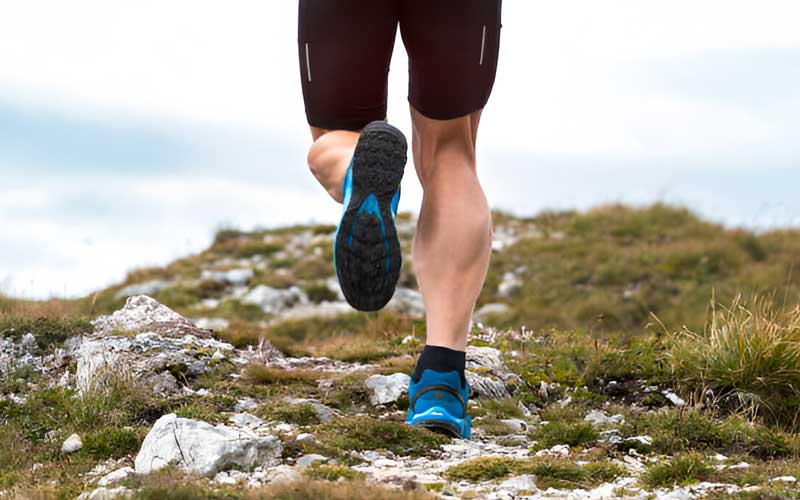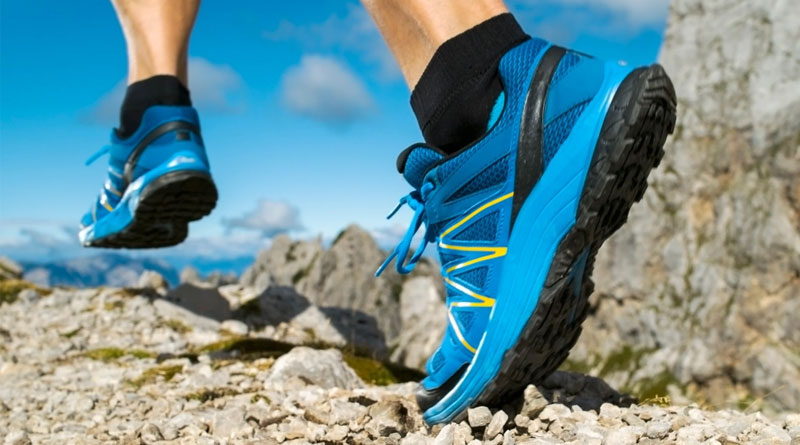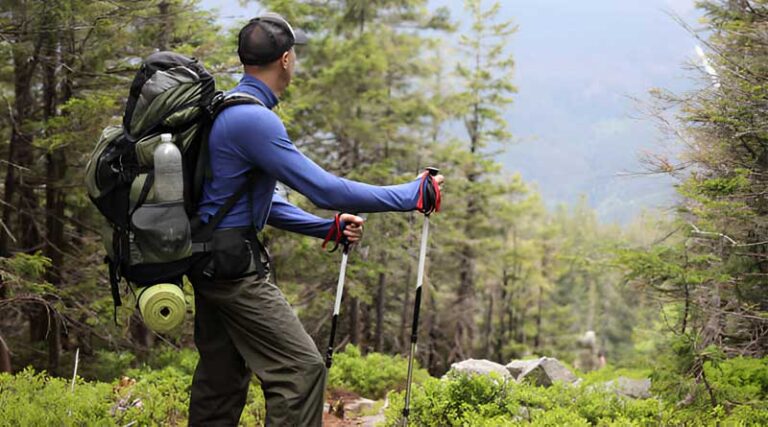Finding the right trail runners for flat feet is important. Without good support, running on rough trails can cause pain. The best shoes provide stability, cushioning, and grip for comfort and safety. They help prevent injuries and make running more enjoyable. Some shoes have arch support, while others use special foam for extra comfort. Breathable materials keep feet cool and dry. A good fit is also key to avoiding blisters and discomfort. With so many choices, it can be hard to decide. This guide will help you find the best flat-foot trail running shoes for both men and women. Enjoy your runs without pain or discomfort!
1. Altra Lone Peak 9

- Cushioning: Moderate
- Drop: 0mm
- Weight (Pair): 1 lb. 6.4 oz.
- Upper: Ripstop mesh
The Altra Lone Peak 9 continues the legacy of one of the most beloved zero-drop trail shoes. With an updated EGO midsole, it strikes a balance between comfort and responsiveness while maintaining its signature roomy toe box and foot-shaped fit. The quick-dry mesh upper improves durability without sacrificing breathability, making it a reliable choice for long-distance adventures. The MaxTrac outsole provides solid grip on various terrains, although deep mud can be a challenge.
This shoe excels for hikers, thru-hikers, and trail runners who prioritize natural foot movement. The Lone Peak 9 remains true to Altra’s zero-drop philosophy, which promotes a more natural stride, but it requires an adjustment period for those new to the design. While the improved midsole provides a smoother ride, it still lacks the bounce of more cushioned options, making it less ideal for those who prefer plush landings on rocky terrain.
Pros:
- Wide toe box for natural foot splay
- Reliable traction on dry and rocky trails
- Comfortable and breathable upper
- Lightweight for a cushioned shoe
Cons:
- Not ideal for deep mud or wet conditions
- Midsole lacks responsiveness for technical terrain
See the Altra Lone Peak 9 See the Women’s Lone Peak 9
2. Topo Athletic Terraventure 4

- Cushioning: Moderate
- Drop: 3mm
- Weight: 1 lb. 4.2 oz.
- Upper: Mesh
The Topo Athletic Terraventure 4 is a versatile trail shoe built for rugged adventures. It features a balanced ZipFoam midsole that offers a blend of comfort and responsiveness, making it a solid choice for both long runs and technical hikes. The Vibram Megagrip outsole is a standout feature, delivering exceptional traction on wet and dry surfaces alike. Additionally, the redesigned mesh upper provides better breathability and durability while incorporating drainage ports to quickly shed water.
One of the biggest strengths of the Terraventure 4 is its combination of stability and agility. The lower drop (3mm) allows for a natural foot strike while still providing enough structure for support. While the toe box is spacious, it’s slightly less roomy than some other Topo models, which may be a consideration for those who prefer a wider fit. The overall durability is impressive, though the shoe can feel a bit stiff until fully broken in.
Pros:
- Excellent grip with Vibram Megagrip outsole
- Comfortable yet stable design for technical trails
- Drainage ports help with wet conditions
- Good balance of cushioning and ground feel
Cons:
- Slightly stiff out of the box
- Toe box could be roomier for some users
See the Topo Athletic Terraventure 4 See the Women’s Terraventure 4
3. Saucony Peregrine 15

- Cushioning: Moderate
- Drop: 4mm
- Weight (Pair): 1 lb. 3.4 oz.
- Upper: Polyester
The Saucony Peregrine 15 is a rugged, all-terrain trail shoe with impressive grip and responsiveness. Featuring an EVA midsole, it delivers a smooth and energetic ride without feeling overly soft. The aggressive Rubber outsole ensures excellent traction on loose dirt, rocky paths, and wet surfaces. The updated upper is more durable and protective while maintaining decent breathability.
This shoe excels for runners who want a grippy, responsive option for technical trails. The 4mm drop encourages a natural running form, though the snug fit may feel restrictive for wider feet. While the Peregrine 15 is comfortable for medium to long distances, those looking for extra cushioning may find it slightly firm for ultra-long runs.
Pros:
- Outstanding traction on various terrains
- Responsive and stable midsole
- Durable upper with protective overlays
- Versatile for both running and hiking
Cons:
- Snug fit may not suit wide-footed runners
- Can feel a bit firm on longer distances
See the Saucony Peregrine 15 See the Women’s Peregrine 15
4. Topo Athletic Pursuit 2

- Cushioning: Moderate
- Drop: 0mm
- Weight (Pair): 1 lb. 5 oz.
- Upper: Recycled mesh
The Topo Athletic Pursuit 2 is a max-cushion, zero-drop trail shoe built for comfort on long-distance runs and hikes. The ZipFoam midsole provides a plush yet responsive feel, while the Vibram Megagrip outsole ensures superior traction on various terrains. The breathable upper keeps feet cool while offering reinforced overlays for added durability.
Ideal for runners seeking both cushioning and a natural foot position, the Pursuit 2 offers a balanced blend of protection and agility. The zero-drop design may require some adjustment for those used to traditional shoes. The wider toe box enhances comfort, but the plush cushioning may feel a bit too soft for highly technical terrain.
Pros:
- Excellent grip with Vibram Megagrip outsole
- Plush yet responsive cushioning
- Wide toe box for comfort
- Breathable and durable upper
Cons:
- Zero-drop may not suit everyone
- Cushioning can feel too soft for technical trails
See the Topo Athletic Pursuit 2 See the Women’s Pursuit 2
5. Altra Superior 7

- Cushioning: Minimal
- Drop: 0mm
- Weight (Pair): 1 lb. 3 oz.
- Upper: Engineered knit
The Altra Superior 7 is a lightweight and agile trail shoe designed for runners who want minimal cushioning and a natural ride. The Quantic midsole provides a firm but slightly cushioned feel, making it ideal for those who prefer a more connected experience with the trail. The MaxTrac outsole ensures solid traction on dry, loose, and rocky terrain, although it may not perform as well in deep mud.
This shoe is best suited for experienced trail runners who enjoy zero-drop designs and a barefoot-like feel. The lightweight ripstop mesh upper enhances breathability while offering improved durability over previous versions. However, the minimal cushioning means less comfort on extremely rocky or long-distance runs. For those who prioritize ground feel and agility, the Superior 7 is a great choice.
Pros:
- Ultra-lightweight and flexible
- Excellent ground feel for technical terrain
- Breathable and durable upper
- Reliable grip on dry surfaces
Cons:
- Minimal cushioning may not suit long runs
- Less traction in muddy conditions
See the Altra Superior 7 See the Women’s Superior 7
6. La Sportiva Bushido III

- Cushioning: Moderate
- Drop: 6mm
- Weight (Pair): 1 lb. 5 oz.
- Upper: Air mesh
The La Sportiva Bushido III is a technical trail shoe designed for runners who need precision and stability on rugged terrain. Featuring a firm EVA midsole, it provides excellent responsiveness without excess softness. The FriXion XT outsole offers superior grip on rocky and uneven trails, making it a top choice for technical mountain running. The reinforced mesh upper, with TPU overlays, enhances durability while maintaining breathability.
This shoe excels in rocky and steep environments, where agility and control are essential. The snug fit and firm cushioning provide a locked-in feel, but they may feel restrictive for runners who prefer a more cushioned ride. While durable and highly protective, the Bushido III is less comfortable for longer distances due to its firmer midsole.
Pros:
- Outstanding grip on technical terrain
- Stable and precise fit
- Durable and protective upper
- Lightweight for a technical shoe
Cons:
- Firm cushioning may not suit long-distance runs
- Narrow fit may not accommodate wider feet
See the La Sportiva Bushido III See the Women’s Bushido III
7. HOKA Speedgoat 6

- Cushioning: Maximum
- Drop: 5mm
- Weight (Pair): 1 lb. 3.6 oz.
- Upper: Woven textile
The HOKA Speedgoat 6 is a highly cushioned trail shoe designed for ultra-distance running and rough terrains. With a CMEVA midsole, it delivers plush cushioning that absorbs impact effectively, making it one of the most comfortable trail shoes available. The Vibram Megagrip outsole with multi-directional lugs ensures superior traction on wet and dry surfaces, improving grip on steep inclines and descents.
This shoe is ideal for runners who prioritize cushioning over ground feel. The wide platform enhances stability, while the updated engineered mesh upper improves breathability and flexibility. However, the high stack height may feel less stable on highly technical terrain. The Speedgoat 6 is a favorite among ultra-runners and hikers looking for maximum comfort over long distances.
Pros:
- Exceptional cushioning for long runs
- Excellent traction with Vibram Megagrip outsole
- Improved breathability and flexibility
- Stable and protective design
Cons:
- High stack height may feel unstable on technical trails
- Bulkier than minimalist trail shoes
See the HOKA Speedgoat 6 See the Women’s Speedgoat 6
Wide-foot Trail Running Shoes: Summary
| SHOES | CUSHIONING | DROP | WEIGHT | UPPER |
|---|---|---|---|---|
| Altra Lone Peak 9 | Moderate | 0mm | 1 lb. 6.4 oz. | Ripstop mesh |
| Topo Athletic Terraventure 4 | Moderate | 3mm | 1 lb. 4.2 oz. | Mesh |
| Saucony Peregrine 15 | Moderate | 4mm | 1 lb. 3.4 oz. | Polyester |
| Topo Athletic Pursuit 2 | Moderate | 0mm | 1 lb. 5 oz. | Recycled mesh |
| Altra Superior 7 | Minimal | 0mm | 1 lb. 3 oz. | Engineered knit |
| La Sportiva Bushido III | Moderate | 6mm | 1 lb. 5 oz. | Air mesh |
| HOKA Speedgoat 6 | Maximum | 5mm | 1 lb. 3.6 oz. | Woven textile |
How to Choose Trail Running Shoes for Flat Feet?

Trail running can be tough on your feet, especially if you have flat feet. Choosing the right shoes is important to prevent pain and injuries. Flat feet mean your arches are lower or absent, making your feet less able to absorb shock. This can cause discomfort and strain on your legs and joints. The right shoes can provide support and stability to keep you running comfortably on uneven terrain.
Understanding Flat Feet
Flat feet occur when the arches of the feet collapse, making the whole sole touch the ground. Some people are born with it, while others develop it over time. It can lead to overpronation, where the feet roll inward excessively while running. This puts stress on the ankles, knees, and hips. If you have flat feet, wearing proper shoes is key to reducing strain and improving performance.
Why Regular Running Shoes May Not Work
Regular running shoes may not provide the support needed for flat feet. Trail running shoes should offer extra stability, arch support, and cushioning. Without these features, runners with flat feet may experience pain and injuries. Uneven trails require shoes with better grip and support to prevent twisting or rolling the ankle.
Key Features to Look for in Trail Running Shoes
When choosing trail running shoes, focus on stability, arch support, and cushioning. Stability helps control foot movement and reduces overpronation. Arch support provides structure to keep the feet aligned. Cushioning absorbs shock, reducing stress on joints and muscles.
Stability and Motion Control
Stability shoes help control excessive foot movement. They are designed for runners who overpronate. Motion control shoes offer even more support for severe overpronation. Both types help keep the feet in the correct position while running on rough trails.
Arch Support and Midsole Design
Good arch support is essential for flat feet. Shoes with built-in arch support help maintain proper foot alignment. The midsole should be firm yet comfortable. A well-designed midsole prevents the foot from collapsing inward and offers extra comfort on rocky paths.
Cushioning for Comfort
Trail running can be hard on the feet, so cushioning is important. Shoes with thick, responsive cushioning absorb impact and reduce fatigue. Look for models with shock-absorbing foam or gel in the midsole. This helps prevent foot pain and discomfort after long runs.
Grip and Traction for Uneven Terrain
Trail surfaces vary from mud and rocks to grass and gravel. Shoes with deep lugs and strong rubber soles provide better grip. Good traction prevents slipping, especially on wet or steep trails. Shoes designed for trails have outsoles that help with stability on rough terrain.
Breathability and Water Resistance
Trail running shoes should keep feet dry and comfortable. Breathable mesh uppers allow air circulation, preventing sweat buildup. Water-resistant materials help keep feet dry in wet conditions. Some models have waterproof membranes, but they may reduce breathability.
Durability and Protection
Rugged trails can wear down shoes quickly. Choose shoes with reinforced toe caps and sturdy materials. A strong upper protects against rocks and roots. Durable outsoles ensure the shoes last longer, even on rough terrain.
Fit and Comfort
A good fit is essential for trail running shoes. Shoes that are too tight can cause blisters, while loose shoes may lead to instability. Try shoes on in the evening when feet are slightly swollen. Leave some space in the toe box for comfort. Ensure the heel is snug to prevent slipping.
Lightweight vs. Heavy Shoes
Lightweight shoes are great for speed and agility. However, heavier shoes offer more support and protection. Runners with flat feet may benefit from a balance between weight and stability. Shoes that are too light may not provide enough support for long runs on uneven ground.
Breaking in Your Trail Running Shoes
New shoes need a break-in period before long runs. Wear them on short walks or runs to allow the feet to adjust. This helps prevent discomfort and blisters. Gradually increase the distance to ensure the shoes are comfortable and supportive.
Choosing Between Different Brands
Several brands offer great options for flat feet. Some popular choices include Brooks, Salomon, ASICS, and HOKA. Each brand has different designs, so trying on multiple pairs helps find the best fit. Look for models with stability features and arch support.
Custom Insoles for Extra Support
Some runners with flat feet benefit from custom insoles. These inserts provide extra arch support and improve comfort. Custom orthotics can be expensive, but they help prevent pain and injuries. Many trail running shoes have removable insoles, allowing for custom inserts.
When to Replace Your Trail Running Shoes
Trail running shoes wear out over time. The cushioning and support break down, reducing their effectiveness. Replace shoes every 300 to 500 miles, depending on usage. Worn-out shoes can lead to discomfort and injuries, so check for signs of wear regularly.
Consulting a Specialist
If you struggle with pain or discomfort, consult a podiatrist. A foot specialist can assess your needs and recommend the best shoes. They may also suggest exercises to strengthen foot muscles and improve stability. Professional advice ensures you choose the right shoes for your running style.
Conclusion
Choosing trail running shoes for flat feet requires attention to support, cushioning, and stability. The right shoes can reduce discomfort and prevent injuries. Look for models with arch support, firm midsoles, and good traction. Trying on different brands and using custom insoles can improve comfort. Proper footwear makes trail running enjoyable and helps protect your feet on rugged terrain.



